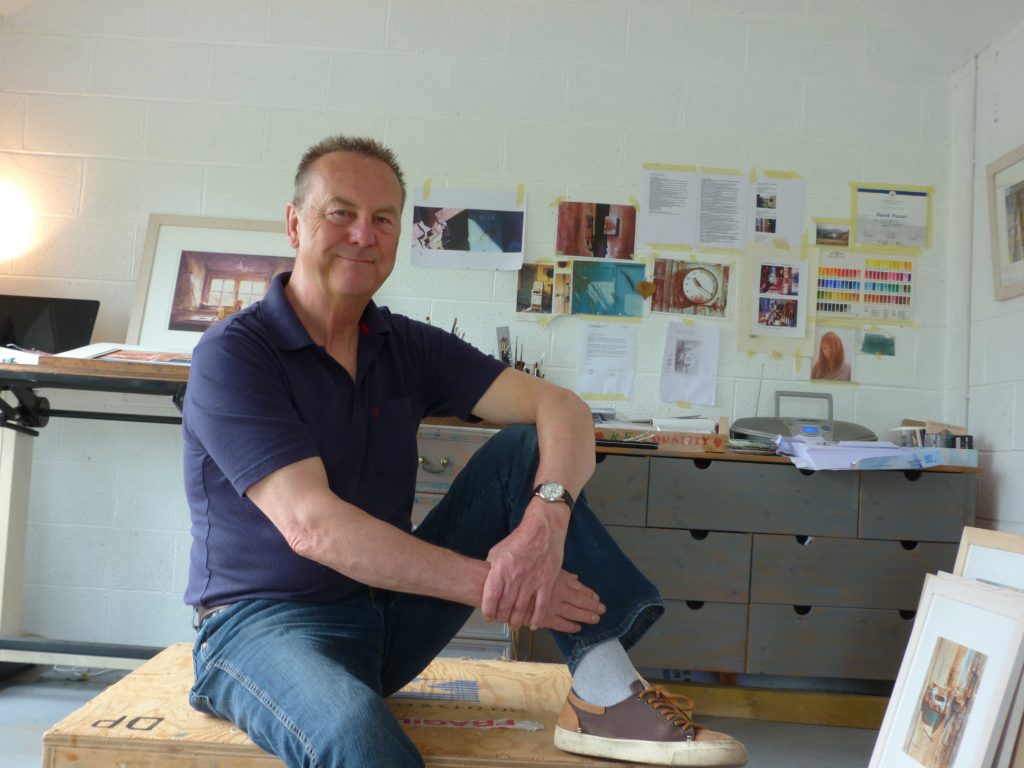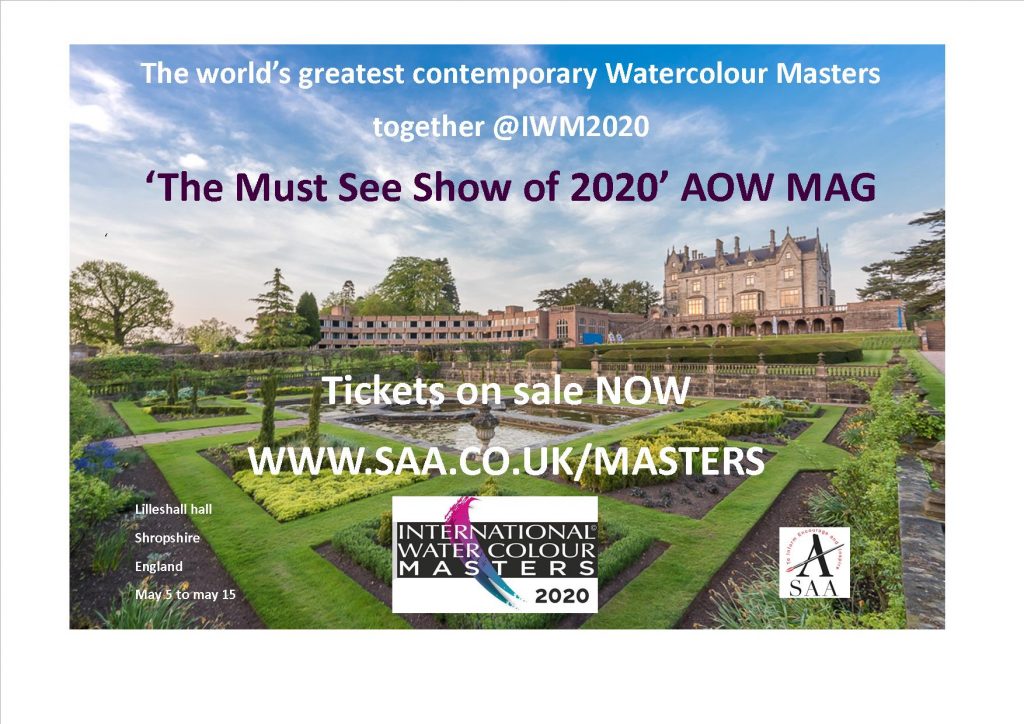David Poxon RI Watercolour Artist
Why don’t you use white paint in any of your work?
Many years ago, I came back to watercolour as my primary medium of expression. I wanted to perfect as many techniques as I could without getting side tracked by the latest gimmicks and painting aids. I decided I would commit to paper, paint, and brushes only and find out how far I could go with this limited arsenal, without getting distracted. In my opinion it is not possible to get whiter than the white of the paper anyway, therefore my particular method of working requires that I preserve areas of white paper to represent any whites that may be in the subject choice.
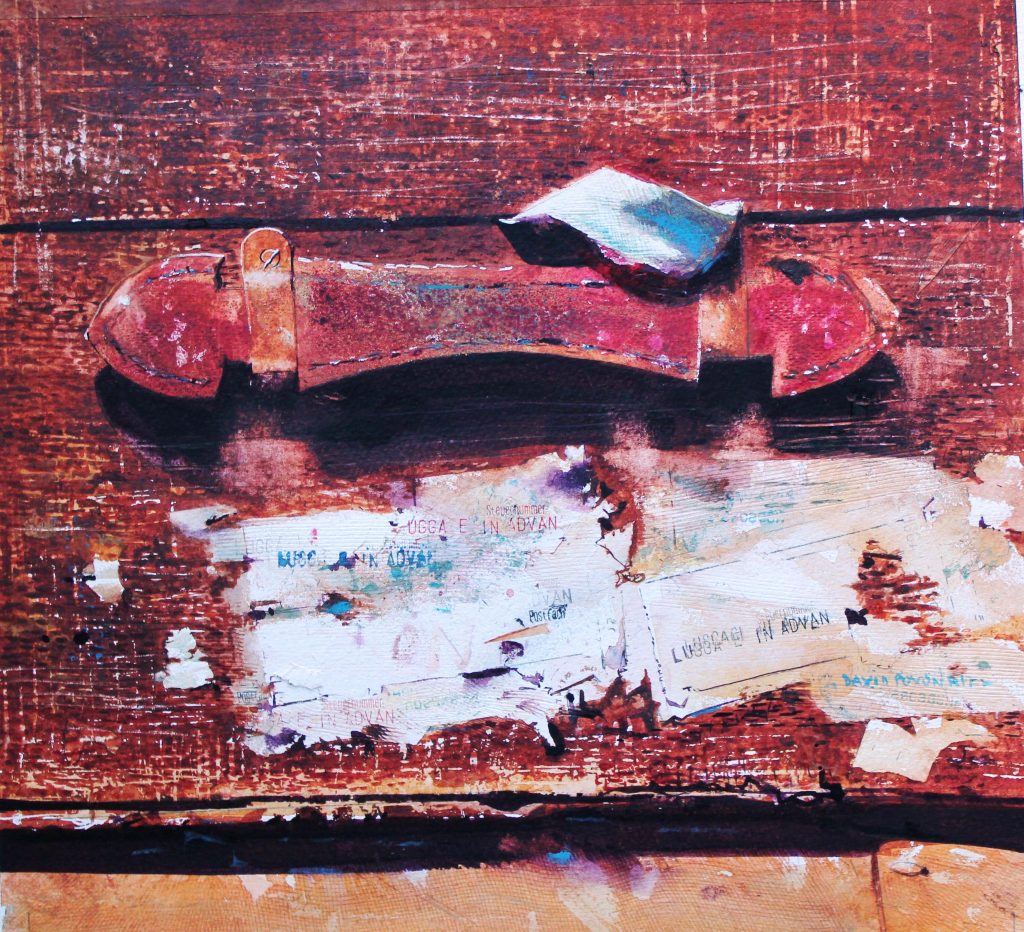
Long Distance Love, Watercolour, 12 x 12 inches
I must confess that I did at one point acquire a tube of white gouache, and experimented with it, however I was disappointed with the results which looked artificial to me, and felt that I was using it out of misplaced laziness rather than for any worthwhile aesthetic reason. From then on I determined to develop my own way and methods of working, a purist approach for me simplifies my choices enabling me to concentrate totally on the modelling of my subjects.
What has led you to focus on reclaimed pieces as your subjects?
My childhood was spent in a heavily Industrial area in the middle of England. Derelict factories and buildings were my playground. My Father was a vegetable merchant who would frequently drive out of the city into the countryside to collect loads of potatoes and vegetables in his truck. Sometimes he took me with him, and the treat of the day was to get a ride on the Farmers Tractor.
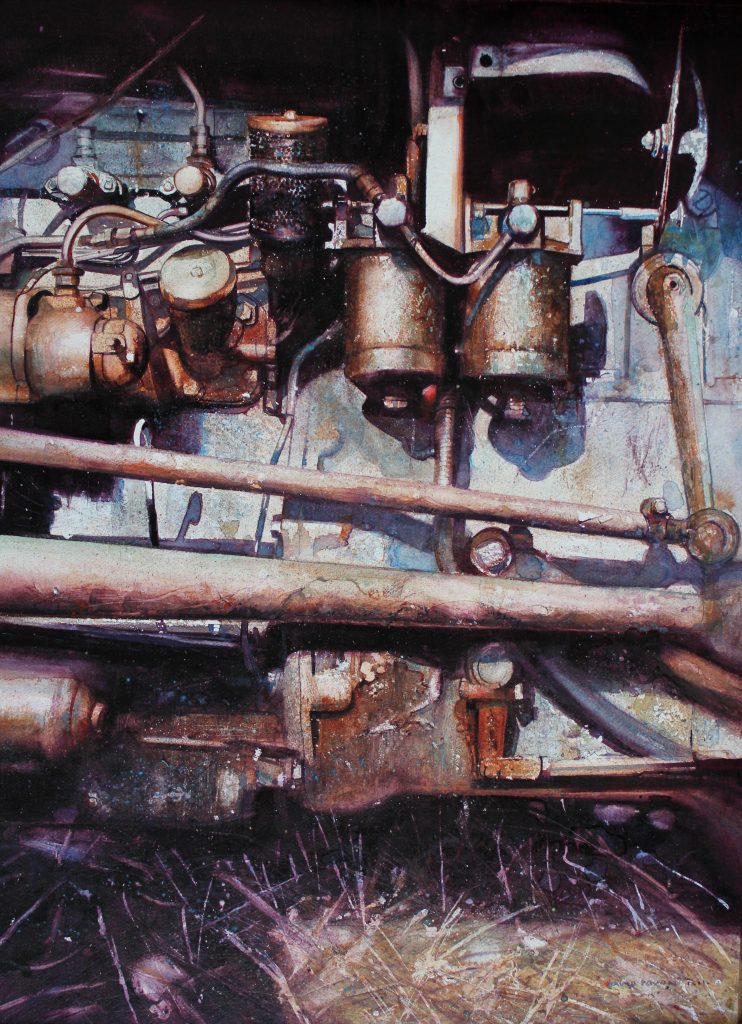
Engine in an Autumn Field, Watercolour, 27 x 18 inches
Tractors, trucks, and factories were the first things I painted. Back home in our yard where he parked his truck there were a mountain of old vegetable crates and boxes, these were a readymade creative output for me as I built the Alamo, Roman Forts, Batmans cave, and anything else that had inspired me that day. I was also painting away on squares of old wall paper lining using my first tin of watercolours, a gift from my Grandmother at the age of five.
Later as a student I experimented with other mediums, styles, and subjects. When I decided to concentrate solely on pure watercolour I followed the time worn path of entering various contests and trying to get admitted to various art clubs. Years ago, entered a contest in Birmingham UK with a painting of an old Qualcast lawn mower.
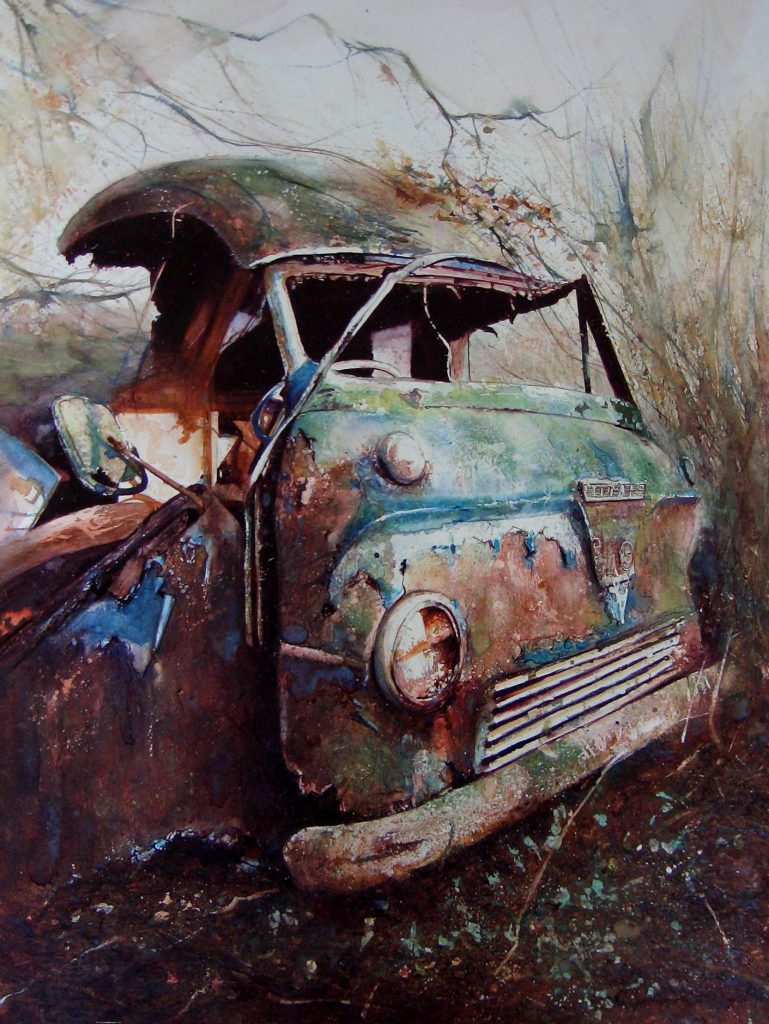
Van in a Wood, Watercolour, 18 x 26 inches
Peeling paintwork, rust, and fading memories of hissing summer lawns long since over grown. I had become disaffected with the usually landscape/townscape/sea subjects and had increasingly been drawn to subjects where nature was busy reclaiming what man had created or cast aside. Zooming in on surface textures, form and shapes, gave me more of a painterly workout. To my amazement I got first prize and also sold the work. This gave me the confidence to pursue the direction I was already on. The abandoned, the over looked, the discarded, all became objects and scenarios with distinct creative possibilities and I had an increasingly strong emotional connection with. I treat all my subjects as portraits in that they are living characters passing through this world just as we are. To me they are more beautiful in their regenerative state than when new, just as people become more interesting and soulful as they age. It is the search for the DNA of a subject that gets my total attention. Wrestling with the technical and emotional challenges of painting in pure watercolour, which requires some serious planning and is not the most forgiving medium, is what gives me the greatest pleasure. It can take many days or weeks to complete a painting, but if you enjoy the painting process like me why would you want to rush it ?
Take one painting and discuss where you found the subject.
What, drew you to it, colour or texture?
‘In a Farmyard’ pure watercolour.
This work is a typical subject for me. Objects seemingly randomly dumped by a farmer in his yard. Fortunately I now live in the wonderful Shropshire countryside, and am surrounded by Farming families, some of whom have taken a great interest in what I do. They have given me the run of their farm yards and buildings, and of course I have never lost my love for Tractors and agricultural machinery.
On a subject hunting trip to Grange Farm I came across this discarded treasure. I never move or rearrange objects as feel this gives the subjects an artificial feel. I prefer to rearrange my position and find the best angle to give me a ready made painting possibility.
The elements in this painting gave me all the forms and surface textures I look for. The smooth but dilapidated chicken feeder, the remnants, rust and paintwork , of an old engine, and other farmyard objects , all held together by an enveloping and powerful strong light and its resulting shadow force.
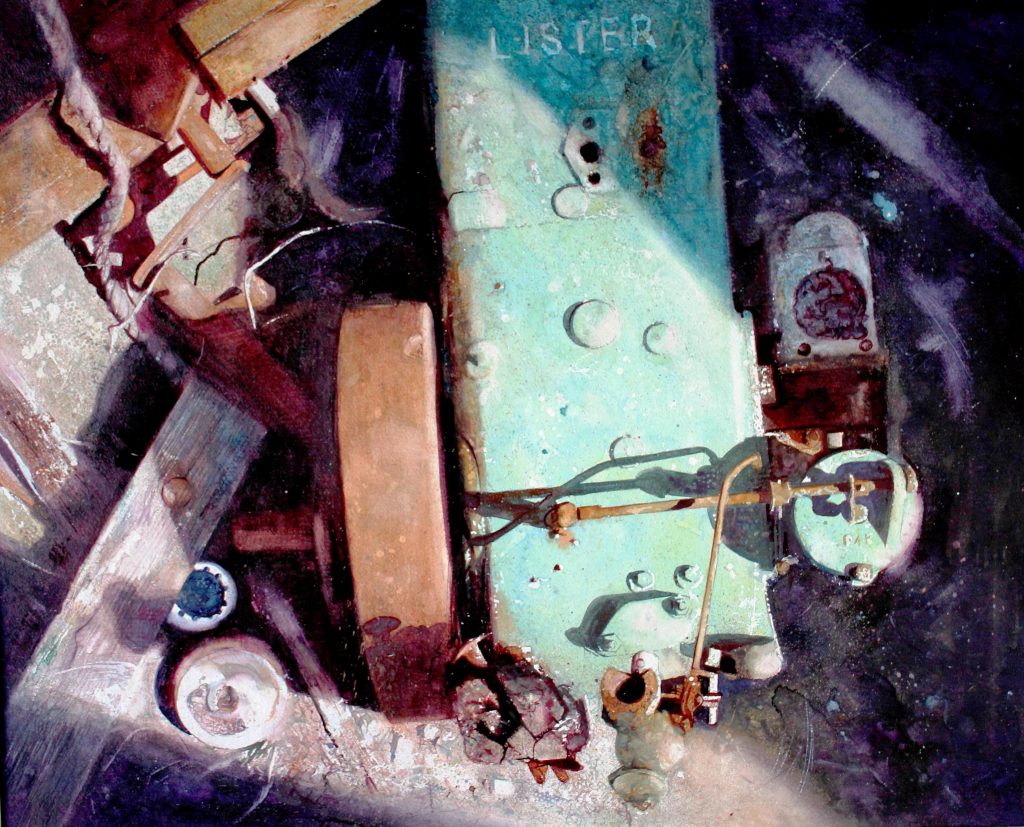
In a Farmyard, Watercolour, 18 x 26 inches
Discuss the logistics of sending your work overseas for exhibitions.
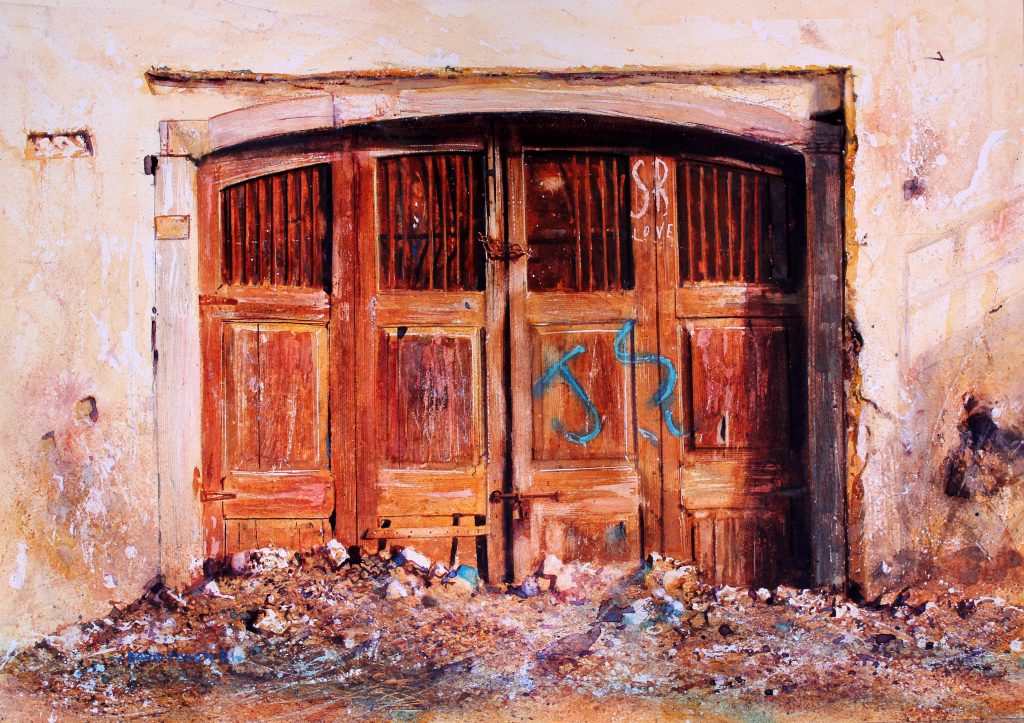
Careless Love, Watercolour, 27 x 17 inches
This depends on the ultimate destination, and different methods apply. Many overseas shows only require that you send your work unframed. In that case it goes rolled in a card tube, is easy to handle, the weight is low, and therefore the costs also.
The danger is that a fair degree of trust must be afforded the organiser in that the paintings need to be framed and presented for view in a professional manner. More typical Gallery situations will require that work is sent framed. In the UK all watercolours for exhibition must be behind glass. Overseas, particularly USA, they require plexi (plastic) glass. This means less weight, and is a safer option than sending glazed work in terms of sustaining damage in transit.. If I am shipping single items to a client, collector, or gallery, then I have specially sized robust cartons for sending single framed paintings. To ship 5+ to a gallery I have a selection of purpose made wooden crates lined with heavy foam inlays. This is a far more expensive shipping option due to the weight and size, and it is important to use a professional art courier who can handle collection and delivery plus the Customs paperwork efficiently.
What led you to writing two books on drawing and watercolour techniques?
I had, over the years, contributed many articles to the Art Press in the Uk and overseas. One of these Interviews had been spotted by the Editing Commissioner at Quarto Books in London. I was approached with the offer of writing and illustrating a drawing book Quarto had been commissioned to supply, ‘Different Strokes Drawing’. After an initial meeting I set to work providing content. Two weeks in they asked me to also work on a second book, the Still Life Drawing Bible. This was a very educational and enjoyable experience, Quarto are a top class outfit who provided excellent management of the project. The books were published world-wide in numerous different languages, did really well, and have been reprinted many times.
Later I was approached several times to author a ‘how to paint’ watercolour book, this is still a project that I will do at some point. However at that time I had ambition to produce a book which would be more biographical and less instructional, containing analysis of my own work rather than explaining basic techniques. I worked with a new Publisher who gave me the design and content freedom I needed. A few months ago Watercolour Heart & Soul was published.
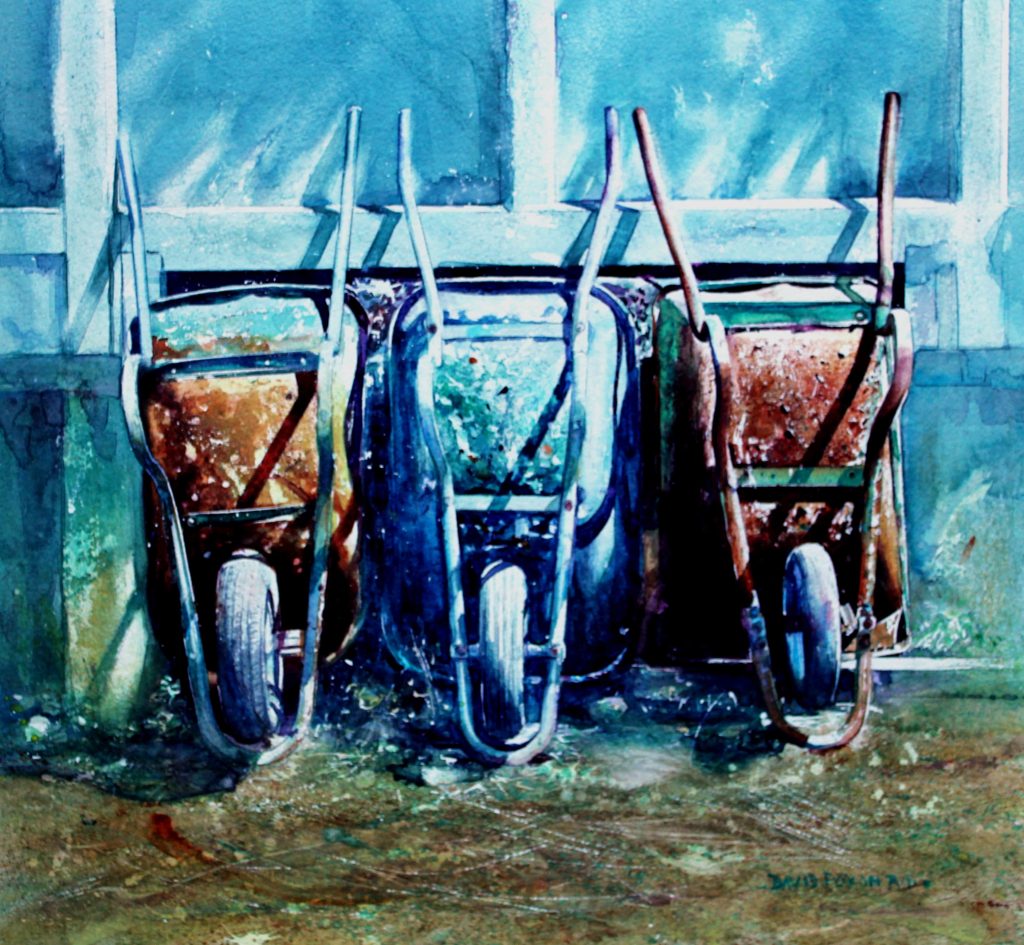
Let’s Go Out Tonight, Watercolour, 27 x 17 inches
Tell us about the International Watercolour Masters in 2020 and your involvement.
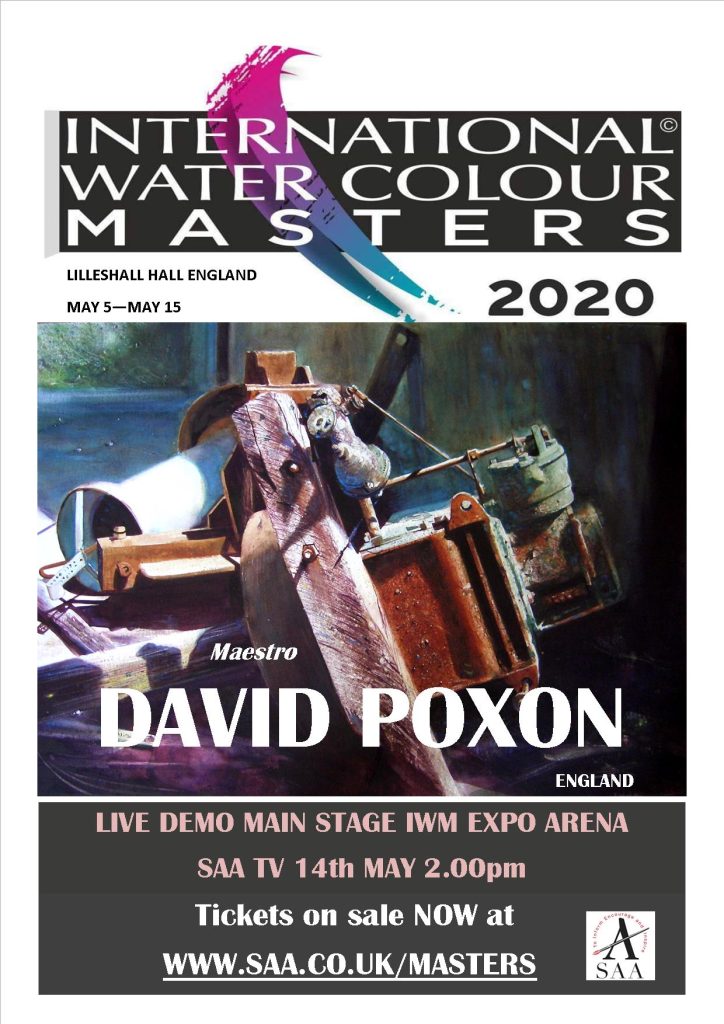
In 2017 I had a large solo show planned for the UK in a fabulous stately home venue. That year I was travelling a lot and on one expo outing in China in a late night discussion with Alvaro (Castagnet) and several other artists on the touring circuit I outlined my plan. Somewhere into the Shanghai night my solo show got set aside and I was persuaded to embark on a far more interesting project, a high profile International show featuring the world’s elite watercolourists. The International Watercolour Masters had been born. Fortunately there was a good selection of talent to draw on in terms of artist roster. In one of my previous working incarnations I had worked in the music Industry organising lots of world tours and logistics for high profile bands. That experience has transferred well to my art life, and particularly International shows. The ‘organiser’ in me does enjoy putting situations together and making them happen. IWM2020 is a much expanded show from iwm2018 which was one of the top selling UK art shows of that year with over 17000 visitors. 2020 will feature 39 elite Master painters, in a bigger venue, and with a far more ambitious programme.
IWM2020, as IWM2018, is presented in the heart of glorious Shropshire Countryside in an historic stately home, Lilleshall Hall. The Exhibition in 2020 will be a total event and day out with myself and team having complete control over all preparation and presentation. We will be present on every show day too. This is a new way of doing things. The days of the high street gallery expo where artists turn up, hang their paintings, then disappear till the end of the show, are numbered in my opinion.
In order for art shows to compete with everything else that tempts the visiting public they have to have a bigger and more attractive offer. The concept of IWM is more about elite festival, and all aspects of its presentation will be first class, to deliver an inspirational day out for visitors. Many of the 39 Master painters will be present throughout the show. Over 34 Live 50 minute TV Demonstrations are scheduled from the IWM Arena main stage. Most of the workshops, which will occur in adjacent seminar rooms, are sold out. Tickets for the show are selling well in UK and overseas, and the TV Advertising in UK will kick in soon, and of course the main draw is the incredible exhibition of paintings that will be on display.
Why do you limit your work to watercolour?
How did this come about?
Well, I also like to draw in pencil, particularly portraits. However I guess I am a persistent sort of person who doesn’t give up easily. Watercolour does test all the nerve ends and asks all the questions, and it can shoot off out of control at any moment. However, trying to juggle all the elements is an endless quest, and I always have it in mind that my best painting will be my next ! It is the easiest medium to pick up, but the hardest to master. I love this medium, its radiance and transparent qualities, and feel like I am only at the beginning.
Expand on one of the amazing setting your work has been exhibited in.
In terms of exotic locations there are few to beat the huge productions which the Chinese have managed to stage. Although these have degenerated recently as economic reality sets in, the early shows, Shanghai Biennale, and Shenzhen Biennale, were incredible. Sponsored and paid for by the state ( $1million for each show) and with top class set up teams, these early exhibitions would be hard to beat or replicate in the future. They set a great benchmark for future organisers to emulate.
When you first began did you dream your art would take you around the world? Discuss this aspect of your art life.
It is very humbling to be in a position where I get invited to lots of exciting places around the world. However, I have always travelled in my working life, so guess this is just an extension of that. It’s great to meet old friends, and make new ones, and talk art all night long!
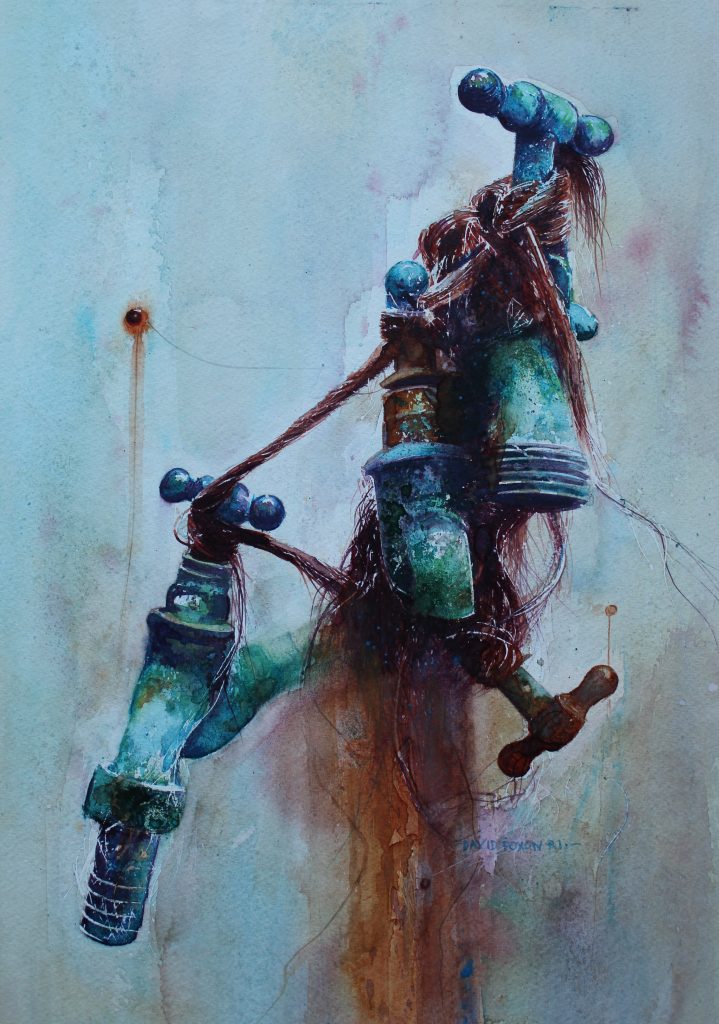
Tap Dancers, Watercolour, 15 x 12 inches
You are a member of the Royal Institute allowing you to use RI after your name. Discuss the process it takes to become a member.
The RI is one of the two oldest and prestigious Societies in the UK over 200 years old. Many Masters from the past, Turner, Girtin, Langley, to name but three, have been members. The current member numbers are approximately 60. Membership is by election, and is quite a convoluted process. Candidates must navigate a number of tests which can take up to 5 years. Consistency of work together with individuality and a mastery of the medium are all considerations, as is being selected to exhibit with the RI in it’s annual London show on at least two previous occasions. Applicants must first get the approval of the RI Council to pass to Candidate status. The final test is to win enough votes from the membership. Membership of the RI is the pinnacle of watercolour artist’s aspirations, so it is a tremendous honour. The Society aims to maintain its prestigious position as the leading UK watercolour organisation by adhering to it’s high standards and admitting only the best very candidates for membership status, it searches for quality not quantity.
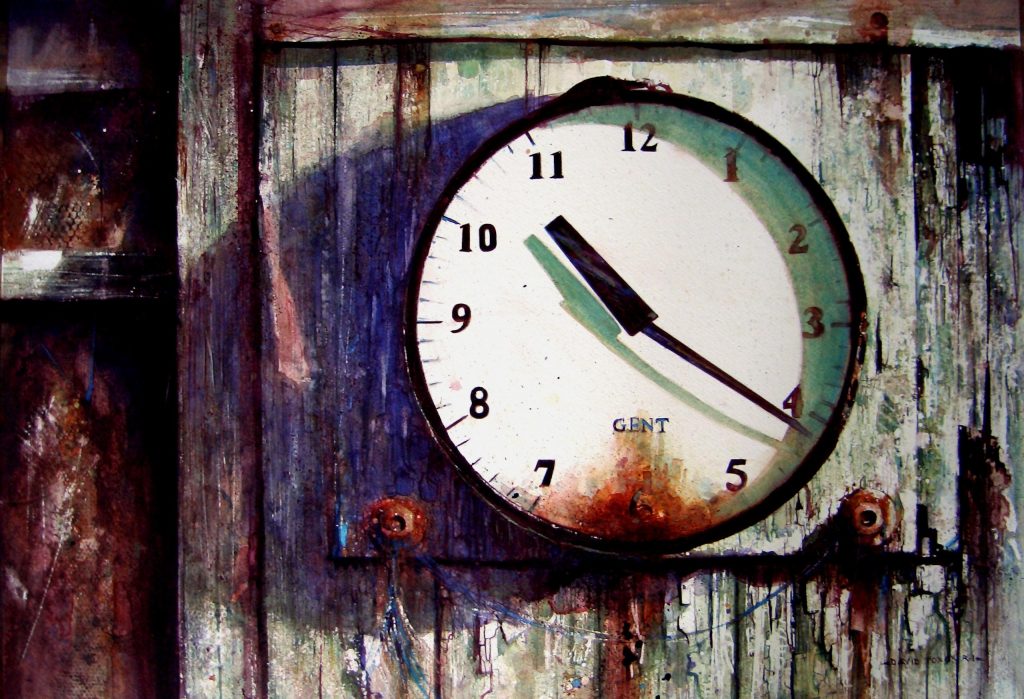
Killing Time, Watercolour, 18 x 26 inches
Take two works where you have use old machinery. Discuss.
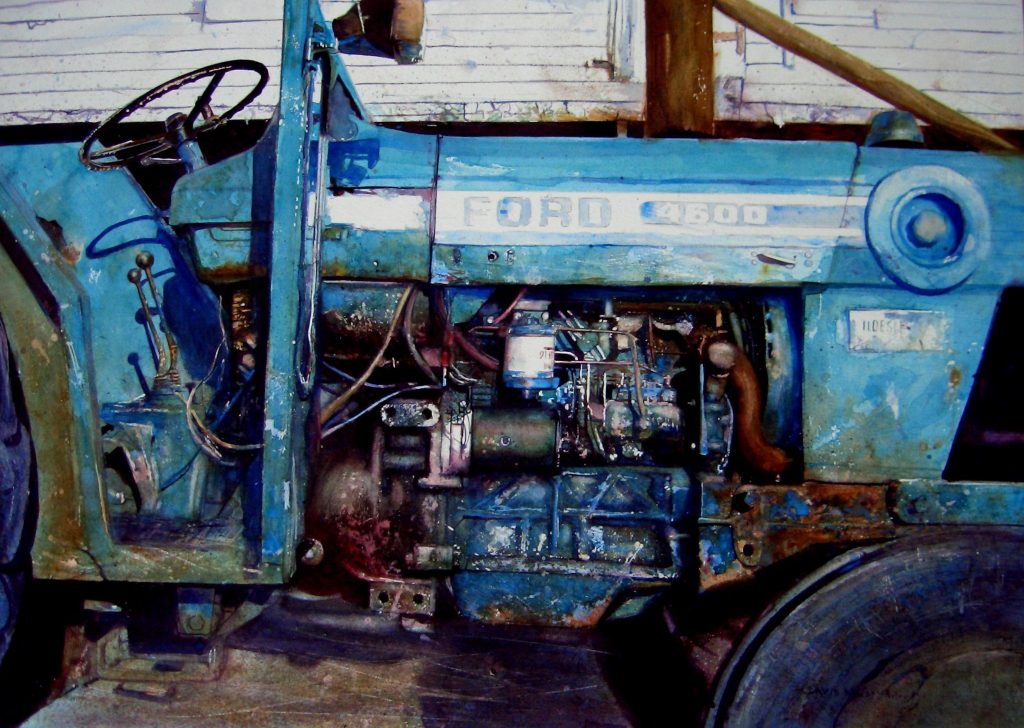
The Day is Done, Watercolour, 27 x 33 inches
This is a working Ford Tractor that often passes my studio. Tractors are regarded as living things by the farmers who drive them. They have to be reliant in all weathers as they plough their miles of furrows. Out of respect for those that work the land, and those that built the implements they work with, I try to be as accurate as I can in the initial drafting. The engines are complicated to draft out, but I spend a long time getting this right before I commit to the watercolour paper. I am not searching for photo realism, I am making a painting, however I have the intention of rebuilding the machine on the paper, and this is my approach when using my multi layering techniques to build form and body.
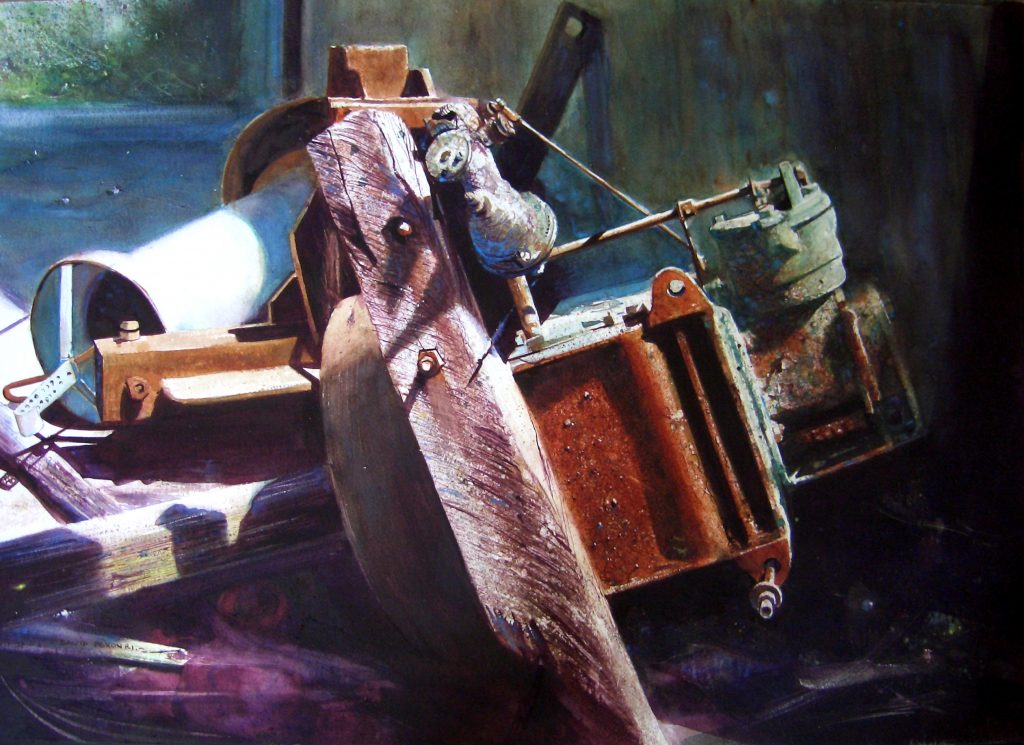
Machinery at a Farm, Watercolour, 17 x 26 inches
This is a painting of an old Lister machine that had been used in a milking parlour. Having come to the end of its working life I came across it basking in the midday sun, left in a heap by it’s owner, I knew immediately this was a subject for me. The beautiful blue green of it’s original paint work still resonated in places, but was now offset by those wonderful rust shades. I really enjoyed this subject. I feel I gave it renewed life and a fitting status, exhibiting it at the RI and winning the Winsor & Newton Award, I guess it’s legacy is confirmed.
You are currently working up to eight months ahead. Discuss the pros and cons of this timeline.
We are all products of our time, affected and shaped by lifes circumstances. Ultimately I don’t think there is any place to hide in painting, the truth will always out, and being truthful to your own abilities and aspirations is paramount. Copiers and imitators lack the personal and emotional connection with the originators concept, there is always something missing.
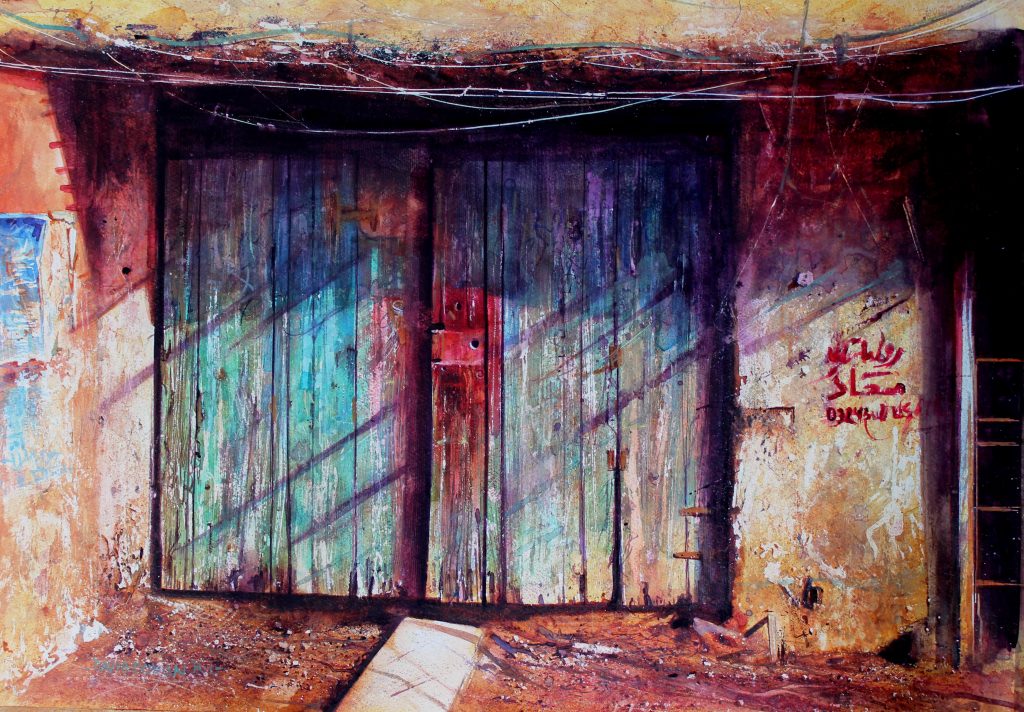
True Colours, Watercolour, 27 x 17 inches
If there is any historical context it is shaped by those circumstances. There are only two things within the control of the individual, their own thoughts, and actions. Everything else is beyond their control.
Watercolour painting is not a race through life, it is a search for yourself.
Contact:
David Poxon RI
davidpoxon.co.uk
david_poxon@yahoo.co.uk
Deborah Blakeley, Melbourne, Australia
Interview by Deborah Blakeley, October 2019
Think a colleague or friend could benefit from this interview?
Knowledge is one of the biggest assets in any business. So why not forward this on to your friends and colleagues so they too can start taking advantage of the insightful information the artist has given?
Other artists you may be interested in:


